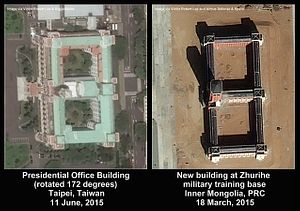Ever since China got a bloody nose in its invasion of Vietnam in 1979, the leadership has struggled to come to terms with managing the spectrum of military activity from normal training to use of force. The lack of sophistication was evident in its use of ballistic missile launches against Taiwan in 1995 and 1996. Both cases said as much about the politics within China’s leadership about the use of force as they did about its capacity to use military power in pursuit of political goals.
The 2013 White Paper titled the “Diversified Employment of China’s Armed Forces” shows a leadership more attuned to the spectrum and how to manage it. The 2015 White Paper, China’s Military Strategy, represents a clear evolution of China’s sophistication in understanding the conflict management spectrum. It places a premium on “enhancing realistic training”: “The PLA will continue to attach strategic importance to combat training in realistic conditions” and “The PLA will continue to conduct live-setting training.” An analysis by Gary Li for the Jamestown Foundation in February 2015 gives us an excellent overview of the poor state of PLA training, and the interest of the leadership in it since 2013. He refers to a decision of the Central Military Commission in 2014 on “Recommendations Concerning the Improvement to the Realism of Military Exercises.” The article provides useful insight into the training facility at Zhurihe.
This provides context for the reports from China and Taiwan in July about the building of a mock-up of the Presidential Palace in Taipei at the Zhurihe training base and its use in combat training. The background above also helps us to understand why the PLA or its political commissars might have wanted to show the attack scenes on Chinese TV.
In terms of military realities, if China was to attack Taiwan – for which it actively plans – the type of military unit involved in seizing the building would probably not be an ordinary garden variety infantry unit. It would probably be a highly specialized unit, either air-dropped in, or more likely infiltrated covertly. Only a small number of troops (perhaps 500-1000) would need to be trained each year for the politically sensitive task of occupying the Presidential offices.
Yet the value to the ground forces of the PLA in showing itself to the leadership as having the political focus on possible use of force against Taiwan and offering realism in training through a mock-up of an urban environment should not be under-estimated. The ground forces are in an environment where they are now competing for funds with the navy, air force and missile force (the main arm of Chinese military strategy toward Taiwan).
Since China’s peace diplomacy toward Taiwan has borne amazing results in the past two decades (after 1996) and since the relationship survived the administration of the independence-oriented Democratic Progressive Party for eight years under Chen Shui-bian, Chinese leaders would think twice before abandoning the current posture in favor of any military pressure.
Yet the airing of the TV footage about attacks on the mock-up of the Presidential offices in Taipei cannot be seen as incidental or routine. It means something. The next Presidential election in Taiwan will be held on January 16, 2016. Somebody in China in a leadership position in the armed forces, the ground forces, the propaganda department or the Central Military Commission is signaling something. We cannot be certain who and why. My best estimate is that this is a signal from the Central Military Commission to both Taiwan and to those in the civilian leadership in China that the military option against Taiwan is very much alive and needs to be on the table. I would not go as far as the headline in The Diplomat about a “mock invasion of Taiwan” indicating a “new level of aggressiveness” by China towards Taiwan.
The article in The Diplomat gives some context to the PLA’s use of mock-ups. Here is a link to another tantalizing episode from 2006 and picked up again in 2011. That location appears to be home to a more fully developed military base on the site, but the mock up there of “terrain” remains.
We should not however confuse our ability to see something with our own eyes and our ability to interpret its intended political meaning. The impact in Taiwan of the TV coverage in China of the attack on the building mock-up was highly negative. Perhaps the intent of the footage was to provoke negative sentiment in Taiwan.

































